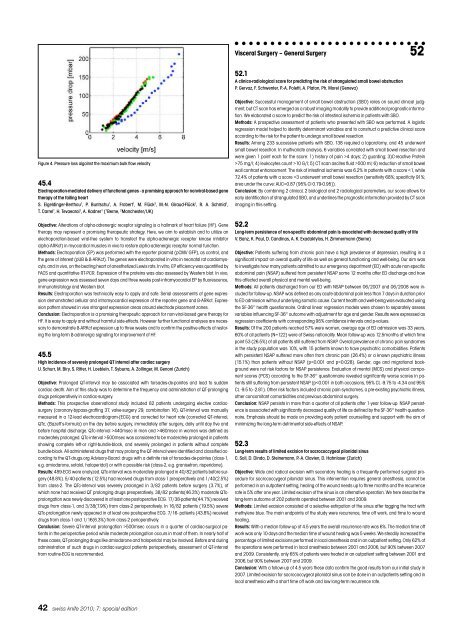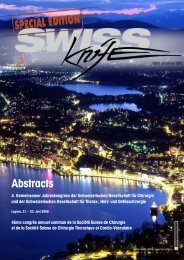Anorectal Manometry in 3D NEW! - Swiss-knife.org
Anorectal Manometry in 3D NEW! - Swiss-knife.org
Anorectal Manometry in 3D NEW! - Swiss-knife.org
Create successful ePaper yourself
Turn your PDF publications into a flip-book with our unique Google optimized e-Paper software.
Figure 4. Pressure loss aiga<strong>in</strong>st the maximum bulk flow velocity<br />
45.4<br />
Electroporation-mediated delivery of functional genes - a promis<strong>in</strong>g approach for nonviral-based gene<br />
therapy of the fail<strong>in</strong>g heart<br />
S. Eigeld<strong>in</strong>ger-Berthou 1 , P. Buntschu 1 , A. Frobert 1 , M. Flück 2 , M.-N. Giraud-Flück 1 , R. A. Schmid 1 ,<br />
T. Carrel 1 , H. Tevaearai 1 , A. Kadner 1 ( 1 Berne, 2 Manchester/UK)<br />
Objective: Alterations of alpha-adrenergic receptor signal<strong>in</strong>g is a hallmark of heart failure (HF). Gene<br />
therapy may represent a promis<strong>in</strong>g therapeutic strategy. Here, we aim to establish and to utilize an<br />
electroporation-based viral-free system to transfect the alpha-adrenergic receptor k<strong>in</strong>ase <strong>in</strong>hibitor<br />
alpha-ARKct) <strong>in</strong> myocardial muscles <strong>in</strong> vivo to restore alpha-adrenergic receptor normal function.<br />
Methods: Electroporation (EP) was performed with the reporter plasmid (pCMV GFP), as control, and<br />
the gene of <strong>in</strong>terest (pUB & ß-ARKct). The genes were electroporated <strong>in</strong> vitro <strong>in</strong> neonatal rat cardiomyocyts,<br />
and <strong>in</strong> vivo, on the beat<strong>in</strong>g heart of anesthetized Lewis rats. In vitro, EP efficiency was quantified by<br />
FACS and quantitative RT-PCR. Expression of the prote<strong>in</strong>s was also assessed by Western blot. In vivo,<br />
gene expression was assessed seven days and three weeks post-<strong>in</strong>tramyocardial EP by fluorescence,<br />
immunohistology and Western blot.<br />
Results: Electroporation was technically easy to apply and safe. Serial assessments of gene expression<br />
demonstrated cellular and <strong>in</strong>tramyocardial expression of the reporter gene and ß-ARKct. Expression<br />
pattern showed <strong>in</strong> vivo strongest expression areas around electrode placement zones.<br />
Conclusion: Electroporation is a promis<strong>in</strong>g therapeutic approach for non-viral-based gene therapy for<br />
HF. It is easy to apply and without harmful side-effects. However further functional analyses are necessary<br />
to demonstrate ß-ARKct expression up to three weeks and to confirm the positive effects of restor<strong>in</strong>g<br />
the long-term ß-adrenergic signal<strong>in</strong>g for improvement of HF.<br />
45.5<br />
High <strong>in</strong>cidence of severely prolonged QT <strong>in</strong>terval after cardiac surgery<br />
U. Schurr, M. Biry, S. Ritter, H. Loeble<strong>in</strong>, T. Syburra, A. Zoll<strong>in</strong>ger, M. Genoni (Zurich)<br />
Objective: Prolonged QT-<strong>in</strong>terval may be associated with torsades-de-po<strong>in</strong>tes and lead to sudden<br />
cardiac death. Aim of this study was to determ<strong>in</strong>e the frequency and adm<strong>in</strong>istration of QT-prolong<strong>in</strong>g<br />
drugs perioperatively <strong>in</strong> cardiac-surgery.<br />
Methods: This prospective observational study <strong>in</strong>cluded 82 patients undergo<strong>in</strong>g elective cardiacsurgery<br />
(coronary-bypass-graft<strong>in</strong>g 37, valve-surgery 29, comb<strong>in</strong>ation 16). QT-<strong>in</strong>terval was manually<br />
measured <strong>in</strong> a 12-lead electrocardiogram-(ECG) and corrected for heart rate (corrected QT-<strong>in</strong>terval,<br />
QTc, (Bazett’s-formula) on the day before surgery, immediately after surgery, daily until day five and<br />
before hospital discharge. QTc-<strong>in</strong>terval >440msec <strong>in</strong> men and >460msec <strong>in</strong> women was def<strong>in</strong>ed as<br />
moderately prolonged. QTc-<strong>in</strong>terval >500msec was considered to be moderately prolonged <strong>in</strong> patients<br />
show<strong>in</strong>g complete left-or right-bundle-block, and severely prolonged <strong>in</strong> patients without complete<br />
bundle-block. All adm<strong>in</strong>istered drugs that may prolong the QT-<strong>in</strong>terval were identified and classified accord<strong>in</strong>g<br />
to the QT-drugs.<strong>org</strong> Advisory-Board: drugs with a def<strong>in</strong>ite risk of torsades-de-po<strong>in</strong>tes (class-1,<br />
e.g. amiodarone, sotalol, haloperidol) or with a possible risk (class-2, e.g. granisetron, risperidone).<br />
Results: 489-ECG were analyzed. QTc-<strong>in</strong>terval was moderately prolonged <strong>in</strong> 40/82 patients before surgery<br />
(48.8%). 5/40-patients (12.5%) had received drugs from class-1 preoperatively and 1/40(2.5%)<br />
from class-2. The QTc-<strong>in</strong>terval was severely prolonged <strong>in</strong> 3/82 patients before surgery (3.7%), of<br />
which none had received QT prolong<strong>in</strong>g drugs preoperatively. 38/82 patients(46.3%) moderate QTcprolongation<br />
was newly discovered <strong>in</strong> at least one postoperative ECG. 17/38-patients(44.7%) received<br />
drugs from class-1, and 3/38(7.9%) from class-2 perioperatively. In 16/82 patients (19.5%) severe<br />
QTc-prolongation newly appeared <strong>in</strong> at least one postoperative ECG. 7/16- patients (43.8%) received<br />
drugs from class-1 and 1/16(6.3%) from class-2 perioperatively.<br />
Conclusion: Severe QT-<strong>in</strong>terval prolongation >500msec occurs <strong>in</strong> a quarter of cardiac-surgical patients<br />
<strong>in</strong> the perioperative period while moderate prolongation occurs <strong>in</strong> most of them. In nearly half of<br />
these cases, QT-prolong<strong>in</strong>g drugs like amiodarone and haloperidol may be <strong>in</strong>volved. Before and dur<strong>in</strong>g<br />
adm<strong>in</strong>istration of such drugs <strong>in</strong> cardiac-surgical patients perioperatively, assessment of QT-<strong>in</strong>terval<br />
from rout<strong>in</strong>e-ECG is recommended.<br />
42 swiss <strong>knife</strong> 2010; 7: special edition<br />
�<br />
Visceral Surgery – General Surgery 52<br />
52.1<br />
A cl<strong>in</strong>ico-radiological score for predict<strong>in</strong>g the risk of strangulated small bowel obstruction<br />
P. Gervaz, F. Schwenter, P.-A. Poletti, A. Platon, Ph. Morel (Geneva)<br />
Objective: Successful management of small bowel obstruction (SBO) relies on sound cl<strong>in</strong>ical judgment,<br />
but CT scan has emerged as a robust imag<strong>in</strong>g modality to provide additional prognostic <strong>in</strong>formation.<br />
We elaborated a score to predict the risk of <strong>in</strong>test<strong>in</strong>al ischemia <strong>in</strong> patients with SBO.<br />
Methods: A prospective assessment of patients who presented with SBO was performed. A logistic<br />
regression model helped to identify determ<strong>in</strong>ant variables and to construct a predictive cl<strong>in</strong>ical score<br />
accord<strong>in</strong>g to the risk for the patient to undergo small bowel resection.<br />
Results: Among 233 successive patients with SBO, 138 required a laparotomy, and 45 underwent<br />
small bowel resection. In multivariate analysis, 6 variables correlated with small bowel resection and<br />
were given 1 po<strong>in</strong>t each for the score: 1) history of pa<strong>in</strong> >4 days; 2) guard<strong>in</strong>g; 3)C-reactive Prote<strong>in</strong><br />
>75 mg/l; 4) leukocytes count >10 G/l; 5) CT scan ascites fluid >500 ml; 6) reduction of small bowel<br />
wall contrast enhancement. The risk of <strong>in</strong>test<strong>in</strong>al ischemia was 6.2% <strong>in</strong> patients with a score 3 underwent small bowel resection (sensitivity 68%; specificity 91%;<br />
area under the curve: AUC=0.87 [95% CI 0.79-0.95]).<br />
Conclusion: By comb<strong>in</strong><strong>in</strong>g 2 cl<strong>in</strong>ical, 2 biological and 2 radiological parameters, our score allows for<br />
early identification of strangulated SBO, and underl<strong>in</strong>es the prognostic <strong>in</strong>formation provided by CT scan<br />
imag<strong>in</strong>g <strong>in</strong> this sett<strong>in</strong>g.<br />
52.2<br />
Long-term persistence of non-specific abdom<strong>in</strong>al pa<strong>in</strong> is associated with decreased quality of life<br />
V. Banz, K. Paul, D. Cand<strong>in</strong>as, A. K. Exadaktylos, H. Zimmermann (Berne)<br />
Objective: Patients suffer<strong>in</strong>g from chronic pa<strong>in</strong> have a high prevalence of depression, result<strong>in</strong>g <strong>in</strong> a<br />
significant impact on overall quality of life as well as general function<strong>in</strong>g and well-be<strong>in</strong>g. Our aim was<br />
to <strong>in</strong>vestigate how many patients admitted to our emergency department (ED) with acute non-specific<br />
abdom<strong>in</strong>al pa<strong>in</strong> (NSAP) suffered from persistent NSAP some 12 months after ED discharge and how<br />
this affected overall physical and mental well-be<strong>in</strong>g.<br />
Methods: All patients discharged from our ED with NSAP between 06/2007 and 06/2008 were <strong>in</strong>cluded<br />
for follow-up. NSAP was def<strong>in</strong>ed as any acute abdom<strong>in</strong>al pa<strong>in</strong> less than 7 days <strong>in</strong> duration prior<br />
to ED admission without underly<strong>in</strong>g somatic cause. Current health and well-be<strong>in</strong>g was evaluated us<strong>in</strong>g<br />
the SF-36 ® health questionnaire. Ord<strong>in</strong>al l<strong>in</strong>ear regression models were chosen to separately assess<br />
variables <strong>in</strong>fluenc<strong>in</strong>g SF-36 ® outcome with adjustment for age and gender. Results were expressed as<br />
regression coefficients with correspond<strong>in</strong>g 95% confidence <strong>in</strong>tervals and p-values.<br />
Results: Of the 200 patients reached 57% were women, average age at ED admission was 33 years,<br />
60% of all patients (N=122) were of <strong>Swiss</strong> nationality. Mean follow-up was 12.5months at which time<br />
po<strong>in</strong>t 53 (26.5%) of all patients still suffered from NSAP. Overall prevalence of chronic pa<strong>in</strong> syndromes<br />
<strong>in</strong> the study population was 10%, with 15 patients known to have psychiatric comorbidities. Patients<br />
with persistent NSAP suffered more often from chronic pa<strong>in</strong> (26.4%) or a known psychiatric illness<br />
(15.1%) than patients without NSAP (p
















